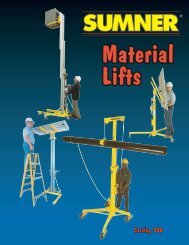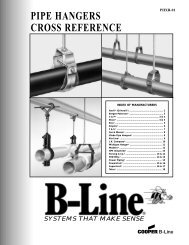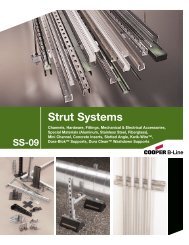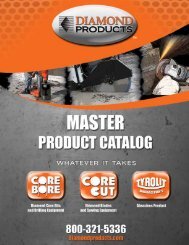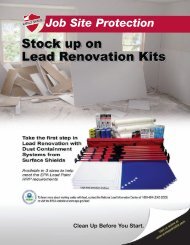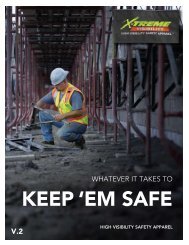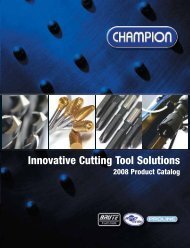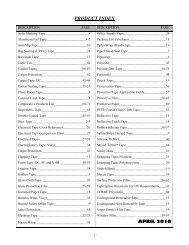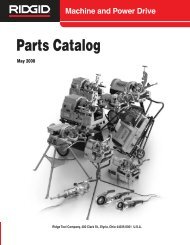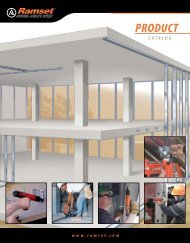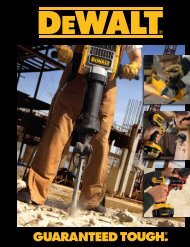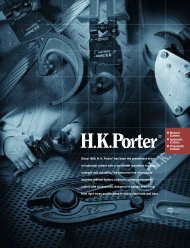Cooper B-Line Seismic Restraints - Dixie Construction Products
Cooper B-Line Seismic Restraints - Dixie Construction Products
Cooper B-Line Seismic Restraints - Dixie Construction Products
You also want an ePaper? Increase the reach of your titles
YUMPU automatically turns print PDFs into web optimized ePapers that Google loves.
TRAPEZE BRACING<br />
Trapeze Assembly Bracing<br />
1). Layout piping and/or conduit runs and determine number, size and location of items to be supported by<br />
the trapeze<br />
2). Determine trapeze support spacing (L T ). This is usually determined by the maximum support spacing of<br />
the smallest pipe or conduit on the trapeze.<br />
3). Select trapeze supports.<br />
a). Determine the total vertical load (T L ) for each trapeze.<br />
T L = L T x W T<br />
T L = Total vertical load for each trapeze support (lbs.)<br />
L T = Trapeze support spacing (ft.)<br />
W T = Weight of all piping, cable tray, ductwork, conduit, etc. in lbs./ft. supported by the trapeze<br />
b). Determine length of trapeze, making sure sufficient length is added to attach the all threaded rod and<br />
bracing attachments. All channel nuts shall be fully engaged within strut.<br />
( 13 /16” (20mm) minimum distance from edge of strut to center line of bolt.)<br />
c). Select type of trapeze member (B22, B22AMIG, etc.) by selecting a member with loading greater<br />
than the total load (T L ). See Table 4 on page 22 for strut loading data, noting that the trapeze beam<br />
span is the distance between the hanger rods. Also determine whether the applied load is uniform or<br />
concentrated, and follow notes on page 22 accordingly. Variations in pipe sizes (simular to concentrated<br />
load assembly on page 22) shall be treated as a concentrated load, where as same sized pipes evenly<br />
distributed across the span (similar to uniform load assembly on page 22) may be treated as a uniform<br />
load. Uniform loads on page 22 are converted to a concentrated load by a 50% reduction. Do not<br />
exceed the beam span length given by Table 4A on page 22, which limits overloading due to<br />
longitudinal seismic force.<br />
d). Determine hanger rod size from Appendix 2 based on total weight (W T ) and trapeze support spacing<br />
(L T ). Rod sizes are given for trapeze supports with braces attached and unbraced trapezes.<br />
e). Select a hanger rod connection to structure (pages 39 thru 56) that is greater than the hanger rod loads<br />
listed in Appendix 2.<br />
4). Select transverse and longitudinal bracing.<br />
a). Select bracing detail from Figures 9 - 11.<br />
b). Determine spacing of transverse / longitudinal bracing from Appendix 2 based on total weight (Wt)<br />
and the trapeze support span (Lt). Note the corresponding structure attachment type (Roman numeral<br />
I - V) for each possible brace interval. When supporting multiple pipe sizes, do not exceed the<br />
maximum spacing for the smallest pipe as given in Appendix 1.<br />
Verify that the specific forces do not exceed the capacity of the pipe clamps on pages 70 & 71.<br />
Take care not to exceed maximum allowable brace beam spans as noted on page 11.<br />
Consult Table 4 and Table 4A, page 22, for trapeze design considerations.<br />
c). Determine if rod stiffener is required (pages 57 & 58).<br />
d). Engineer of record for a site specific project shall verify that the structure can support the<br />
connection loads in addition to all other loads.<br />
5). Review the design and revise layout where loads exceed the limitations of the hanger rods, strut trapeze<br />
supports, or connection details.<br />
COOPER B-<strong>Line</strong><br />
509 West Monroe Street<br />
Highland, Illinois 62249<br />
Phone: 800-851-7415<br />
Fax: 618-654-1917<br />
Date:<br />
Page No.<br />
Sheet Number:<br />
6 - 2 - 06<br />
17<br />
of<br />
Raafat S. Aboulhosn<br />
Structural Engineer S 3913



